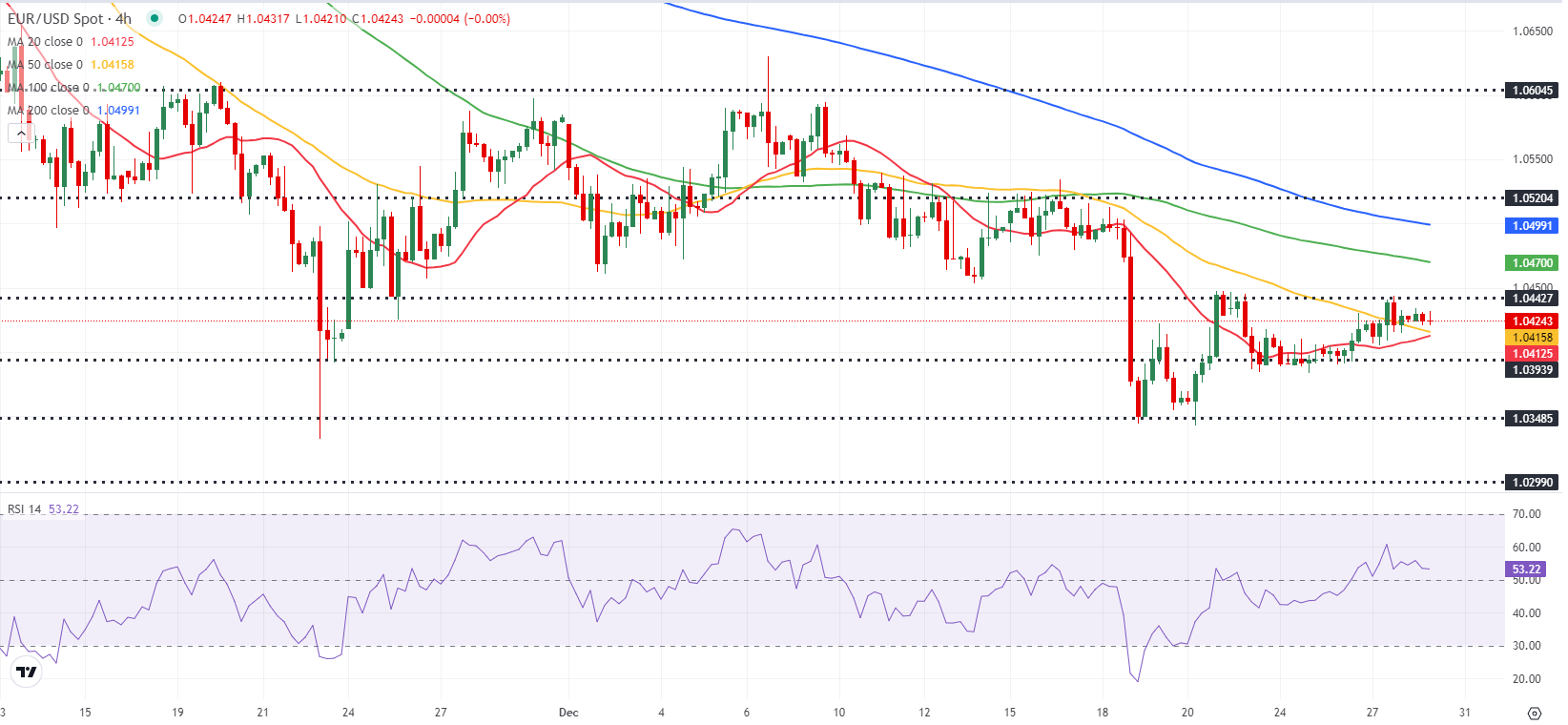- EUR/USD continues to trade in a narrow channel above 1.0400.
- The near-term technical outlook fails to offer a directional clue.
- Cautious comments from ECB officials help the Euro stay resilient against its rivals.
After ending the holiday-shortened week virtually unchanged, EUR/USD extends its sideways grind slightly above 1.0400 in the European session on Monday. The pair is likely to remain stuck in a tight range, with trading conditions unlikely to normalize until after the New Year holiday.
Euro PRICE Last 7 days
The table below shows the percentage change of Euro (EUR) against listed major currencies last 7 days. Euro was the weakest against the New Zealand Dollar.
| USD | EUR | GBP | JPY | CAD | AUD | NZD | CHF | |
|---|---|---|---|---|---|---|---|---|
| USD | 0.09% | -0.06% | 0.93% | 0.23% | 0.20% | -0.13% | 1.04% | |
| EUR | -0.09% | -0.17% | 0.77% | 0.12% | 0.18% | -0.23% | 0.94% | |
| GBP | 0.06% | 0.17% | 0.91% | 0.29% | 0.35% | -0.05% | 1.12% | |
| JPY | -0.93% | -0.77% | -0.91% | -0.65% | -0.65% | -1.02% | 0.05% | |
| CAD | -0.23% | -0.12% | -0.29% | 0.65% | 0.02% | -0.36% | 0.81% | |
| AUD | -0.20% | -0.18% | -0.35% | 0.65% | -0.02% | -0.41% | 0.76% | |
| NZD | 0.13% | 0.23% | 0.05% | 1.02% | 0.36% | 0.41% | 1.13% | |
| CHF | -1.04% | -0.94% | -1.12% | -0.05% | -0.81% | -0.76% | -1.13% |
The heat map shows percentage changes of major currencies against each other. The base currency is picked from the left column, while the quote currency is picked from the top row. For example, if you pick the Euro from the left column and move along the horizontal line to the US Dollar, the percentage change displayed in the box will represent EUR (base)/USD (quote).
In an interview with Austrian newspaper Kurier over the weekend, European Central Bank (ECB) Governing Council member Robert Holzmann said that it might take more time until the ECB cuts rates again. "There are signs of an upward trend in some energy prices. But there are also other scenarios as to how inflation could return, like via a stronger devaluation of the euro," Holzmann elaborated.
These comments seem to be helping the Euro hold its ground. In the second half of the day, Pending Home Sales for November and Chicago Purchasing Managers Index for December will be featured in the US economic calendar. These data, however, are unlikely to influence the US Dollar's (USD) valuation in a noticeable way.
In the meantime, US stock index futures trade in negative territory, reflecting a cautious market mood. In case Wall Street's main indexes turn south after the opening bell, EUR/USD could have a hard time keeping its footing.
EUR/USD Technical Analysis
The Relative Strength Index (RSI) indicator on the 4-hour chart holds slightly above 50 and EUR/USD stays above the 20 and the 50-period Simple Moving Averages (SMA), reflecting a lack of seller interest.
EUR/USD could face first resistance at 1.0440 (static level) before 1.0470 (100-period SMA) and 1.0500 (200-period SMA). On the downside, 1.0400 (round level, static level) could be seen as interim support ahead of 1.0350 (static level) and 1.0300 (static level, round level).
Euro FAQs
The Euro is the currency for the 19 European Union countries that belong to the Eurozone. It is the second most heavily traded currency in the world behind the US Dollar. In 2022, it accounted for 31% of all foreign exchange transactions, with an average daily turnover of over $2.2 trillion a day. EUR/USD is the most heavily traded currency pair in the world, accounting for an estimated 30% off all transactions, followed by EUR/JPY (4%), EUR/GBP (3%) and EUR/AUD (2%).
The European Central Bank (ECB) in Frankfurt, Germany, is the reserve bank for the Eurozone. The ECB sets interest rates and manages monetary policy. The ECB’s primary mandate is to maintain price stability, which means either controlling inflation or stimulating growth. Its primary tool is the raising or lowering of interest rates. Relatively high interest rates – or the expectation of higher rates – will usually benefit the Euro and vice versa. The ECB Governing Council makes monetary policy decisions at meetings held eight times a year. Decisions are made by heads of the Eurozone national banks and six permanent members, including the President of the ECB, Christine Lagarde.
Eurozone inflation data, measured by the Harmonized Index of Consumer Prices (HICP), is an important econometric for the Euro. If inflation rises more than expected, especially if above the ECB’s 2% target, it obliges the ECB to raise interest rates to bring it back under control. Relatively high interest rates compared to its counterparts will usually benefit the Euro, as it makes the region more attractive as a place for global investors to park their money.
Data releases gauge the health of the economy and can impact on the Euro. Indicators such as GDP, Manufacturing and Services PMIs, employment, and consumer sentiment surveys can all influence the direction of the single currency. A strong economy is good for the Euro. Not only does it attract more foreign investment but it may encourage the ECB to put up interest rates, which will directly strengthen the Euro. Otherwise, if economic data is weak, the Euro is likely to fall. Economic data for the four largest economies in the euro area (Germany, France, Italy and Spain) are especially significant, as they account for 75% of the Eurozone’s economy.
Another significant data release for the Euro is the Trade Balance. This indicator measures the difference between what a country earns from its exports and what it spends on imports over a given period. If a country produces highly sought after exports then its currency will gain in value purely from the extra demand created from foreign buyers seeking to purchase these goods. Therefore, a positive net Trade Balance strengthens a currency and vice versa for a negative balance.
Information on these pages contains forward-looking statements that involve risks and uncertainties. Markets and instruments profiled on this page are for informational purposes only and should not in any way come across as a recommendation to buy or sell in these assets. You should do your own thorough research before making any investment decisions. FXStreet does not in any way guarantee that this information is free from mistakes, errors, or material misstatements. It also does not guarantee that this information is of a timely nature. Investing in Open Markets involves a great deal of risk, including the loss of all or a portion of your investment, as well as emotional distress. All risks, losses and costs associated with investing, including total loss of principal, are your responsibility. The views and opinions expressed in this article are those of the authors and do not necessarily reflect the official policy or position of FXStreet nor its advertisers. The author will not be held responsible for information that is found at the end of links posted on this page.
If not otherwise explicitly mentioned in the body of the article, at the time of writing, the author has no position in any stock mentioned in this article and no business relationship with any company mentioned. The author has not received compensation for writing this article, other than from FXStreet.
FXStreet and the author do not provide personalized recommendations. The author makes no representations as to the accuracy, completeness, or suitability of this information. FXStreet and the author will not be liable for any errors, omissions or any losses, injuries or damages arising from this information and its display or use. Errors and omissions excepted.
The author and FXStreet are not registered investment advisors and nothing in this article is intended to be investment advice.
Recommended Content
Editors’ Picks

GBP/USD pressured around 1.2900 after UK Budget report
GBP/USD remains under pressure, trading near fresh one-week lows sub-1.2900. Inflationary pressures kept easing in the United Kingdom, with annual CPI up by 2.8% in February, after printing at 3% in January. Chancellor Rachel Reeves delivers the Spring Statement, discusses the state of public finances.

EUR/USD stays below 1.0800 after upbeat US data
EUR/USD struggles to gain traction and trades below 1.0800 in the American session on Wednesday. Upbeat February Durable Goods Orders data from the US support the US Dollar in the second half of the day, making it difficult for the pair to stage a rebound.

Gold clings to modest daily gains above $3,020
Gold fluctuates in a relatively tight range and manages to hold above $3,020 midweek. The precious metal seems to be benefiting from the positive sentiment surrounding the commodities after Copper climbed to a new all-time high earlier in the day.

Bitcoin holds $87,000 as markets brace for volatility ahead of April 2 tariff announcements
Bitcoin (BTC) holds above $87,000 on Wednesday after its mild recovery so far this week. A K33 Research report explains how the markets are relatively calm and shaping up for volatility as the market absorbs the tariff announcements.

Sticky UK services inflation shows signs of tax hike impact
There are tentative signs that the forthcoming rise in employer National Insurance is having an impact on service sector inflation, which came in a tad higher than expected in February. It should still fall back in the second quarter, though, keeping the Bank of England on track for three further rate cuts this year.

The Best brokers to trade EUR/USD
SPONSORED Discover the top brokers for trading EUR/USD in 2025. Our list features brokers with competitive spreads, fast execution, and powerful platforms. Whether you're a beginner or an expert, find the right partner to navigate the dynamic Forex market.
